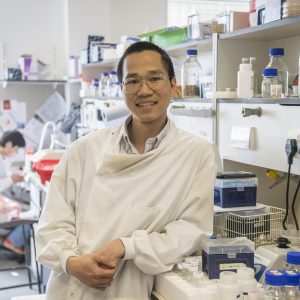
Tung Le’s group studies how the chromosome is organised spatially and segregated faithfully, using a simplified bacterial system.
The chromosomes of all living organisms must be compacted by nearly three orders of magnitude to fit within cells. Moreover, DNA must be packaged in a way that is compatible with a myriad of DNA-based processes, including replication, segregation, transcription, repair, and recombination.
This challenge is particularly acute in bacteria as chromosome segregation occurs alongside DNA replication rather than being separated temporally, as in eukaryotes.
How chromosome organisation and its integration with biological processes are achieved in vivo remains poorly understood. To fill this knowledge gap, the lab aims to:
- Elucidate the molecular mechanisms underlying chromosome organisation and segregation
- Unravel the relationship between spatial chromosome organisation (locally and globally) and important biological processes in the cell
To do this the group are working to answer the following questions;
- How does Structural Maintenance of Chromosomes (SMC) protein interactions with DNA to organise bacterial chromosomes?
- How does the centromere-binding protein ParB interact with DNA to recruit SMC?
- Evolution of protein-DNA interfaces
In particular, the group focus their resources on investigating how the Structural Maintenance of Chromosomes (SMC) protein interacts with DNA to organise the bacterial chromosome, specifically in an aquatic bacterium Caulobacter crescentus. The investigation of SMC is a perfect starting place for the lab since SMC plays a central role in chromosome organisation and segregation in most organisms, and is highly conserved from bacteria to humans. Furthermore, there is a great synergy between the bacterial and eukaryotic SMC research fields, and their research has benefited tremendously from the recent explosion of interest in, and technological advances from the eukaryotic chromosome organisation field.
The combination of genetics, cell biology, and genome-wide techniques (ChIP-seq and Hi-C) has proved to be very effective in investigating SMC in the Le lab.
In the long term, the group aim to apply similar approaches to investigate other classes of chromosome-structuring proteins. The ultimate aim of the lab is to understand the integration of actions of different classes of architecture proteins in organising the chromosome.
Tung Le is an Honorary Professor at the University of East Anglia.
Selected Publications
-
Jalal A. S. B., Tran N. T., Le T. B. K. (2020)ParB spreading on DNA requires cytidine triphosphate in vitro.eLife (9)Publisher's version: 2050-084X
-
Jalal ASB,Tran NT,Stevenson CE,Chan EW,Lo R,Tan X,Noy A,Lawson DM,Le TBK (2020)Diversification of DNA-Binding Specificity by Permissive and Specificity-Switching Mutations in the ParB/Noc Protein FamilyCell Reports (32)Publisher's version: 2211-1247
-
Tran N. T., Laub M. T., Le T. B. (2017)SMC Progressively Aligns Chromosomal Arms in Caulobacter crescentus but Is Antagonized by Convergent Transcription.Cell reports (20)Publisher's version: 2211-1247
